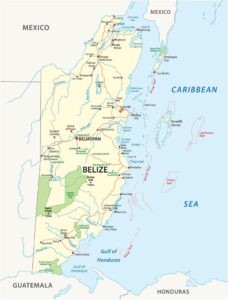Across the centuries, the territorial borders of Belize have evolved through a rich and contentious historical narrative. You might wonder why the boundary separating Belize from Guatemala is represented as dotted on various maps; this visual representation signifies a deeply entrenched territorial dispute. This long-standing conflict traces its roots back to historical claims made by Guatemala, which has continuously contested Belize’s sovereignty since the latter achieved independence. The potential for international tension remains considerable, as both nations actively engage in diplomatic negotiations aimed at resolving this boundary issue. Delving into this geopolitical puzzle uncovers the intricate challenges surrounding national borders in Central America, where colonial legacies and concepts of territorial integrity intersect in potentially volatile ways.
Unpacking the Historical Claims Fueling the Belize-Guatemala Dispute
The enduring territorial conflict between Belize and Guatemala can be traced back to a complex web of historical and colonial legacies. This dispute originates from the colonial era, a time when territorial boundaries were often vaguely defined and prone to interpretation. The unresolved border issue has persisted for centuries, leading to ongoing tension between these two neighbouring nations and affecting their diplomatic relations in profound ways, often spilling into broader regional issues.

Delving into Guatemala’s Enduring Territorial Claims Over Belize
At the heart of the dispute lies Guatemala’s persistent assertion of historical territorial rights over Belize, which is deeply rooted in the Spanish colonial administrative boundaries. You might be surprised to learn that Guatemala views Belize as part of its original territorial inheritance from the Spanish Empire, thereby contesting the modern borders established during the British colonial period. This historical perspective continues to fuel Guatemala’s claims and significantly complicates the sovereignty issue, as it intertwines with national identity and historical grievances.
Investigating the Consequences of Historical Borders on Modern Diplomacy
Since the colonial era, these disputed boundaries have fostered significant geopolitical challenges for both nations involved. It is evident how undefined border regions create potential for conflict and diplomatic tensions, impacting local communities and their sense of national identity. Understanding the border dispute unravels complex layers of historical, legal, and territorial dynamics, revealing how these implications extend beyond mere geographical lines. They encompass economic, cultural, and security risks that are crucial to the stability of the region. The ongoing conflict has substantial ramifications for regional stability, international law, and the potential for future negotiations between Belize and Guatemala, highlighting the need for constructive dialogue.
The Importance of the Dotted Line Representing the Border on Maps
When examining maps, you may notice a distinctive feature: a dotted boundary line between Belize and Guatemala, which signifies an unresolved territorial dispute that has persisted for decades. This unique cartographic representation highlights a complex geopolitical challenge, where the exact border remains undefined and contested. The dotted line serves as a symbol of the ongoing diplomatic tension and the unresolved territorial claims that have defined the interactions between these two Central American nations over the years.
The Role of International Recognition in the Ongoing Border Dispute
In the realm of international relations, Belize is recognised as a sovereign state with an established international presence; however, the disputed border with Guatemala introduces a nuanced geopolitical scenario. It may intrigue you that while Belize achieved independence in 1981, Guatemala has historically challenged its territorial integrity. The dotted line not only indicates geographical ambiguity but also signifies an ongoing diplomatic negotiation that continuously shapes regional relations and perceptions, reflecting the complexities of international recognition.
The Diplomatic Symbolism of the Dotted Line on Maps
Beyond its representation on maps, the dotted line functions as a significant diplomatic symbol. You can interpret it as a visual manifestation of unresolved territorial claims, signalling to the international community the intricate negotiations between Belize and Guatemala. This unique border marking communicates the ongoing dialogue and the potential for a peaceful resolution to the conflict. However, the dotted line embodies more than just a cartographic curiosity; it represents a delicate diplomatic instrument that helps mitigate potential military escalation while maintaining an open channel for negotiation.
This line acts as a strategic buffer, enabling both nations to preserve diplomatic relations and work towards a possible future resolution. Its existence showcases how international borders can be managed through peaceful means, illustrating a sophisticated approach to territorial disputes that prioritises dialogue over confrontation, ultimately fostering an environment conducive to resolution.

Key Conflicts and Diplomatic Agreements Shaping Belize and Guatemala's Relations
The territorial disputes between Belize and Guatemala are deeply entrenched in history and characterised by complex diplomatic tensions and unresolved boundary claims. You’ll discover that the ongoing disagreement revolves around competing interpretations of colonial-era treaties and the broader concept of territorial sovereignty. This dispute has far-reaching implications for both nations, involving potential land ownership challenges and regional geopolitical dynamics that continue to shape their relationship, often complicating efforts towards cooperation.
The Consequences of the 1859 Treaty and Related Developments
Prior to the signing of the 1859 treaty between Britain and Guatemala, territorial boundaries within the region were ambiguous and fiercely contested. It’s essential to understand that this agreement aimed to establish clear borders; however, subsequent interpretations have led to ongoing disputes. Guatemala has consistently challenged the validity of the treaty, asserting that Britain failed to fulfil certain commitments regarding infrastructure development, which has become a pivotal point of contention in their territorial disagreement and remains a source of frustration.
Recent International Court of Justice Involvement and Ongoing Diplomatic Efforts
Recent diplomatic initiatives have focused on resolving the long-standing border dispute through international legal frameworks. You’ll note that both nations have agreed to submit their case to the International Court of Justice (ICJ) for a binding resolution. This strategy signifies a significant advancement towards peaceful conflict resolution and the potential to normalise bilateral relations, reflecting a commitment to addressing historical grievances through established legal channels.
In addition to the ICJ proceedings, it’s vital to recognise the intricate diplomatic negotiations that have transpired. The potential referendum in both countries to validate the ICJ’s decision represents a unique and democratic method for resolving territorial disputes. Your understanding of this process underscores the delicate diplomatic efforts aimed at maintaining regional stability while resolving historical territorial claims through peaceful and internationally recognised mechanisms.
Assessing the Current Situation and Travel Considerations for Visitors
Many travellers find themselves intrigued by Belize’s unique border configuration with Guatemala. The ongoing territorial dispute has created a complex geopolitical landscape that impacts travel and border crossings. Despite the existing tensions, tourists continue to visit both countries, navigating the delicate diplomatic situation while considering international boundaries and local regulations that may affect their travel plans.
Essential Guidelines for Safe Border Crossing
When planning international travel to Belize, it’s essential to prepare diligently and consider these important guidelines:
- Ensure you carry a valid passport and any necessary travel documents, including visas if required
- Check the current state of diplomatic relations before embarking on your journey to ensure a smooth experience
- Obtain appropriate travel insurance tailored to your needs for your trip
- Stay informed about border crossing procedures and potential delays to avoid complications
The most crucial aspect is to maintain awareness of your surroundings and respect local regulations to ensure a seamless travel experience while being mindful of the historical context surrounding the border.
Community Perspectives and Local Sentiments Regarding the Dispute
Behind the border dispute lie deep-rooted historical tensions and intricate cultural dynamics that shape local opinions. Communities situated near the border directly experience the impacts of the dispute, with generational memories of conflict profoundly influencing their perspectives. Residents often navigate a tightrope between national pride and a desire for peaceful coexistence, highlighting the human element in this geopolitical issue, as local narratives often diverge from national discourses.
Gaining Deeper Insights into the Dynamics of Border Communities
To truly understand the local perspective, you should explore the nuanced landscape of cultural identity. You’ll discover that border communities have devised unique survival strategies, blending resilience with diplomatic pragmatism. Indigenous groups, in particular, play a critical role in nurturing cross-border relationships, often transcending official diplomatic tensions through grassroots connections and shared cultural experiences, fostering a sense of unity amid conflict and contributing to local identity.

Anticipating Future Implications of the Belize-Guatemala Border Dispute
Despite the ongoing territorial dispute, there exists a potential for significant geopolitical transformations. The unresolved border issue between Belize and Guatemala continues to foster tension, with implications that could reshape diplomatic relations in Central America. You might observe that successfully resolving this dispute could have profound effects on regional stability, economic cooperation, and the international perceptions of both nations, potentially opening avenues for collaboration.
Continuing Dialogue as a Means of Addressing the Dispute
Dialogue remains the primary mechanism for addressing the territorial disagreement. You will find that both countries have engaged in diplomatic negotiations, seeking peaceful resolutions through international platforms like the Organization of American States (OAS). These conversations represent a commitment to avoiding military confrontation and finding a mutually acceptable solution to their long-standing border dispute, emphasising the importance of dialogue in conflict resolution and the pursuit of understanding.
Exploring Potential Pathways Towards Resolution of the Dispute
Above all, you should understand that multiple strategies exist for resolving the border conflict. International mediation and bilateral negotiations present promising avenues for progress. You might envision approaches such as joint territorial management, referendums, or interventions from international courts as viable methods to effectively address the dispute in a manner that respects both nations' rights and concerns.
The implications of successfully resolving the conflict extend far beyond simple border demarcation. You will discover that effective negotiations could unlock significant economic opportunities for both Belize and Guatemala, fostering a more cooperative regional environment. Potential benefits could include enhanced trade, improved cross-border cooperation, and increased foreign investment. The most transformative outcome would be establishing permanent territorial sovereignty, which could dramatically reduce regional tensions and promote long-term stability in Central America, positively influencing future generations.
Understanding the Regional Dynamics Surrounding the Belize-Guatemala Conflict
Unlike other border disputes in Central America, the Belize-Guatemala territorial conflict is steeped in deep historical complexities that have significantly influenced regional geopolitical interactions. You’ll find that this longstanding disagreement reflects broader patterns of territorial tension, involving colonial legacies, post-independence territorial claims, and intricate diplomatic negotiations that have deeply shaped the political landscape of the region, often spilling over into wider Central American relations.
The Impact of the Dispute on Relations within Central America
After decades of territorial disputes, you can observe how this conflict has strained diplomatic relationships between Belize and Guatemala. The ongoing tension has periodically disrupted regional cooperation, creating challenges for economic integration and mutual understanding within the broader Central American community, often complicating joint initiatives that could benefit both nations.
The Role of International Organisations in Mediation Efforts
With diplomatic mediation playing a critical role, international organisations have actively engaged in efforts to resolve the border dispute. You’ll notice that entities like the Organization of American States (OAS) have been instrumental in facilitating dialogue and proposing viable resolution strategies, often acting as intermediaries to promote understanding and cooperation.
A comprehensive network of international organisations has been strategically involved in addressing the Belize-Guatemala border dispute. The United Nations, OAS, and various diplomatic channels have worked tirelessly to prevent escalation, offering mediation services and promoting peaceful negotiation. You’ll appreciate how these organisations have helped maintain stability, providing a structured approach to resolving territorial disagreements and mitigating potential military confrontations, reinforcing the importance of international collaboration.
Reflecting on the Complexities of the Belize-Guatemala Border Dispute
Weaving together the intricate threads of Belize’s territorial history, you can see how the nation’s border with Guatemala serves as a testament to unresolved colonial legacies. As you explore this geopolitical puzzle, you’ll understand that the dotted border symbolizes more than a mere cartographic curiosity; it represents ongoing diplomatic negotiations and historical tensions that continue to shape both nations. Your comprehension of this dispute reveals the intricate challenges facing post-colonial states, where territorial boundaries persist in igniting international dialogue. The unresolved status underscores the delicate balance between historical claims and modern diplomatic resolutions, inviting you to appreciate the nuanced complexity of international border disputes and their ramifications.

Frequently Asked Questions Regarding the Belize-Guatemala Border Dispute
What is the reason for the dotted border between Belize and Guatemala?
The dotted border signifies a long-standing territorial dispute between Belize and Guatemala, originating from conflicts that date back to the colonial era. Spain initially claimed the territory, and after Belize gained independence from Britain in 1981, Guatemala continued to assert its territorial claims, leading to an undefined border demarcation depicted by the characteristic dotted line on maps.
Has a resolution been reached regarding the border dispute between Belize and Guatemala?
The dispute remains partially unresolved; however, significant progress has been made. In 2019, both countries agreed to submit the territorial disagreement to the International Court of Justice (ICJ) for a binding resolution. A referendum in both nations endorsed this approach, indicating a diplomatic pathway towards definitively settling the border controversy.
What are the historical origins of the border conflict between Belize and Guatemala?
The conflict originates from the 1859 treaty between Britain and Guatemala, which promised infrastructure development in exchange for territorial recognition. When Britain failed to fully meet these commitments, Guatemala began challenging Belize’s territorial integrity. This historical misunderstanding has perpetuated decades of tension, with Guatemala maintaining claims over approximately 53% of Belize’s current national territory.
The Article Why Is Belize’s Border Dotted? Exploring the Guatemala Dispute appeared first on Belize Travel Guide
The Article Belize’s Border Dotted: Unraveling the Guatemala Dispute Was Found On https://limitsofstrategy.com

